new posts in all blogs
Viewing: Blog Posts Tagged with: Using First Book, Most Recent at Top [Help]
Results 1 - 17 of 17
How to use this Page
You are viewing the most recent posts tagged with the words: Using First Book in the JacketFlap blog reader. What is a tag? Think of a tag as a keyword or category label. Tags can both help you find posts on JacketFlap.com as well as provide an easy way for you to "remember" and classify posts for later recall. Try adding a tag yourself by clicking "Add a tag" below a post's header. Scroll down through the list of Recent Posts in the left column and click on a post title that sounds interesting. You can view all posts from a specific blog by clicking the Blog name in the right column, or you can click a 'More Posts from this Blog' link in any individual post.

By: Marissa Wasseluk,
on 10/25/2016
Blog:
First Book
(
Login to Add to MyJacketFlap)
JacketFlap tags:
spooky stories,
halloween books for kids,
Five Favorites,
Monthly book list,
book list,
Books & Reading,
book recommendations,
children's book recommendations,
First Book Marketplace,
First Book Favorites,
5 favorites,
Our Recommendations,
Using First Book,
Using the First Book Marketplace,
The First Book Marketplace,
Add a tag
First Book’s book experts picked their favorite spooky stories that will frighten and delight young readers. Don’t be afraid to pick up any of our recommended titles!
Pre-K –K (Ages 3-6):
 Ghosts in the House! written and illustrated by Kazuno Kohara
Ghosts in the House! written and illustrated by Kazuno Kohara
At the edge of town lives a clever girl with a spooky problem: Her house is haunted! Luckily, she happens to be a witch and knows a little something about taking care of ghosts.
We love this book because: it’s got just the right amount of sweet and scary for the youngest trick-or-treaters. Fresh and charming illustrations in dynamic orange, black and white bring this resourceful heroine and these spooky ghosts to life.
For 1st and 2nd Grade (Ages 6-8):
 Los Gatos Black on Halloween written by Marisa Montes and illustrated by Yuyi Morales
Los Gatos Black on Halloween written by Marisa Montes and illustrated by Yuyi Morales
Follow los monstruos and los esqueletos to a Halloween party in a fun and frightful bilingual poem. Accompanied by illustrations that are as gorgeous as they are creepy, this is a great Halloween-themed read-aloud book that kids will want to read and re-read all year long.
We love this book because: this book introduces young readers to a spooky array of Spanish words that will open their ojos to the chilling delights of the season.
For 3rd & 4th grade (Ages 8-10):
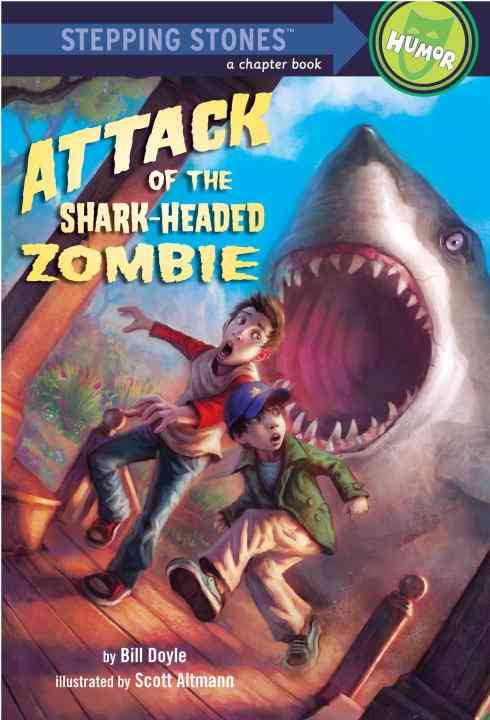 Attack of the Shark-Headed Zombie by Bill Doyle
Attack of the Shark-Headed Zombie by Bill Doyle
After Keats and Henry lose their bikes, they need money – fast. So the help-wanted ad at the supermarket seems ideal for them. All they have to do is weed Hallway House’s garden, find some light bulbs in the attic, sweep the garage…and battle a shark-headed zombie.
We love this book because: With an imaginative youngster as its main character, this book weaves the tale of an exciting and fun adventure that will keep kids turning pages and entertain even reluctant readers.
For 5th & 6th grade (Ages 10-12):

Ghost Fever / Mal de fantasma (Bilingual, English/Spanish) by Joe Hayes
Elena Padilla’s father didn’t believe in ghosts, and that’s a shame, because his disbelief ends up making Elena a very sick girl. The story starts in an old rundown house in a dusty little town in Arizona. Nobody will rent that house because … well, a ghost haunts it. The landlord can’t even rent it out for free! That is, not until foolish old Frank Padilla comes along thinking he can save some money.
Lucky for Elena that her grandmother knows all about the mysterious ways of ghosts. With her grandmother’s help and advice, Elena solves the mystery of the ghost girl, recuperates from her ghost fever and, in the process, learns a valuable lesson about life.
We love this book because: It’s really scary! The incredible details of this story – with English and Spanish on opposite pages – will stay with readers after the story ends. Children who enjoy a good fright will really love this book.
Grades 7 & up (Ages 13+):
 Lockwood & Co. #1: The Screaming Staircase by Jonathan Stroud
Lockwood & Co. #1: The Screaming Staircase by Jonathan Stroud
A sinister Problem has occurred in London: all nature of ghosts, haunts, spirits, and specters are appearing throughout the city, and they aren’t exactly friendly. Only young people have the psychic abilities required to see—and eradicate—these supernatural foes.
We love this book because: Complex and endearing characters navigate an alternate reality wherein the dead don’t die – what’s not to love? The book’s fantastic world is sure to hook readers – even we can’t wait to pick up the next title in the series!
The post Monthly Book List: Our Five Favorites for October appeared first on First Book Blog.


By: Guest Blogger,
on 10/21/2016
Blog:
First Book
(
Login to Add to MyJacketFlap)
JacketFlap tags:
Literacy,
Education,
Sesame Street,
teaching resources,
Guest Blog Posts,
early childhood education,
education technology,
joan ganz cooney,
Michael Levine,
new america,
Opportunities for You,
Using First Book,
Using the First Book Marketplace,
The First Book Marketplace,
How to Use First Book Resouces,
campaign for grade level reading,
digital reading resources,
Lisa Guernsey,
tap click read,
Add a tag

The following is a guest blog post from Michael H. Levine & Lisa Guernsey, authors of the book Tap, Click, Read.
Kids today use a wide variety of tools to learn. How do educators adapt teaching tactics to effectively use modern day tools?
New America and the Joan Ganz Cooney Center at Sesame Workshop have become known for our joint research and analysis on how digital technologies could be used to improve, instead of impede, early literacy. We have collaborated on the book Tap, Click, Read and developed a toolkit designed to help educators put these insights into practice. The Tap, Click, Read toolkit – comprised of fourteen research-based resources including tipsheets, discussion guides, ratings lists, and a quiz—are now downloadable for free on the First Book Marketplace.
On the First Book Marketplace you’ll find resources for educators, caregivers, and community leaders:
- What Educators Can Do—A list of recommendations for updating teaching methods, working with libraries and public media, and more.
- What Parents Can Do—A list of ideas for parents and caregivers, including the importance of listening to and talking with children about the media they use and why.
- How to Use Media to Support Children’s Home Language—Used well, media can spark opportunities for children to converse with their family members at home in their native languages. This helps them build a foundation for learning English too.
- How to Promote Creation and Authorship—Children need to learn what it means to be a creator, not just a consumer, of media. New tools bring this concept to life.
- How to Find Apps for Literacy Learning—Choose wisely. Use app-review sites and advice from literacy experts to find materials that match your students’ needs.
- The Three C’s—Content, context, and the individual child. Become more mindful in using digital technology with young children by taking this quiz.
- A Modern Action Plan for States and Communities—A guide for community and state leaders on how to make progress in solving America’s reading crisis and strengthening family-centered approaches that will endure over time.
- 12 Actions to Take Now—A one-page list of “must-dos” for community leaders, district administrators, and policymakers to break out of the literacy crisis and bring opportunities to all children.
We are so proud to team up with First Book to provide the children you serve with access to quality 21st-century literacy opportunities. Click here to learn more about our partnership, and visit the Joan Ganz Cooney Center blog for more resources that guide learning through digital tools – including bilingual video vignettes and discussion guides.
The post “Tap, Click, Read” Toolkit – Promoting Early Literacy in a World of Screens appeared first on First Book Blog.


By: First Book Staff,
on 8/25/2016
Blog:
First Book
(
Login to Add to MyJacketFlap)
JacketFlap tags:
Marketplace,
Recess,
Sports Equipment,
More Than Books,
Using First Book,
The First Book Marketplace,
learning and play,
play education,
Target Grant,
Target Stores,
teaching kids with play,
Add a tag

Experts say that one way to help your kids get a jump on learning is to help them, well, JUMP! Boosting students’ physical activity not only supports health and wellness and makes kids feel better, but it turns out that it can help them learn better, too.
That’s why First Book is excited to announce a brand new addition to the First Book Marketplace lineup of resources: sports and fitness equipment provided through Target.
“Whether it’s dribbling a basketball, playing softball, or maneuvering through an obstacle course, physical activity can improve academic achievement, boost cognitive skills and improve concentration and behavior for kids – both in and out of the classroom,” said Kyle Zimmer, First Book president and CEO. “Thanks to Target, many more schools and programs serving kids in need will have the resources to encourage healthy activities that also foster learning.”
Through Target funding, First Book will now offer brand new softballs, soccer balls, bean bag toss games, playground balls and more on the First Book Marketplace.
If you’re a teacher serving children in need, you may be able to take advantage of special funding from Target that will provide credits that educators can use to access sports equipment from the First Book Marketplace site. So run – don’t walk – to find the sports and play equipment you need to support learning and wellness for the children you serve.
The post Active Bodies, Active Minds: Boost Wellness & Learning with Sports Equipment appeared first on First Book Blog.


By: Marissa Wasseluk,
on 8/23/2016
Blog:
First Book
(
Login to Add to MyJacketFlap)
JacketFlap tags:
resources for teachers,
Using First Book,
Using the First Book Marketplace,
The First Book Marketplace,
grl,
guided reading levels,
how to use the first book marketplace,
resources for educators,
children's books,
Video,
First Book Marketplace,
Add a tag
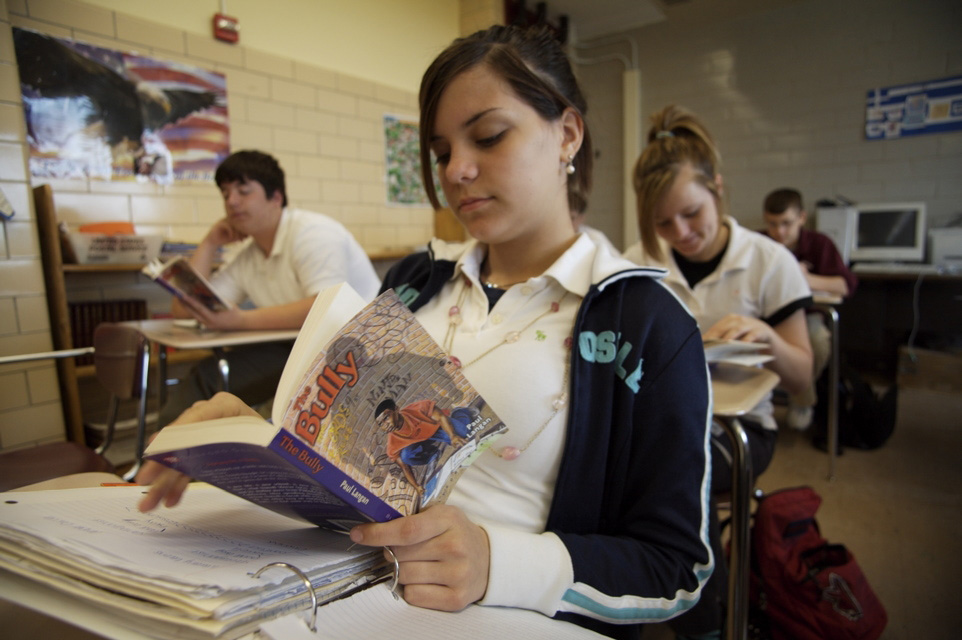 Use Guided Reading Levels to find the perfect books for every child you serve. Thanks to the feedback from our community of educators, First Book Marketplace users can now utilize our Advanced Search tool to find books with Guided Reading Levels (GRLs). GRLs are great for both students and educators.
Use Guided Reading Levels to find the perfect books for every child you serve. Thanks to the feedback from our community of educators, First Book Marketplace users can now utilize our Advanced Search tool to find books with Guided Reading Levels (GRLs). GRLs are great for both students and educators.
Here’s why:
GRLs help educators:
- Assess the fluency and reading level of each child
- Track student progress over time
- Organize school and classroom libraries so that educators and kids can access the best-fit books for every child
GRLs help students:
- Find books at their level of confidence
- Develop the skills they need to read increasingly challenging books
- Discover books they will love to read again and again
Watch the short video tutorial below to learn more about how to the First Book Marketplace’s Advanced Search to find books by GRL:
If you’re an educator serving kids in need, click here to register to receive brand-new books for the children you serve for free or low cost.
The post Use Guided Reading Levels to Find the Perfect Books on the First Book Marketplace appeared first on First Book Blog.


By: Gavin McGuire,
on 7/7/2016
Blog:
First Book
(
Login to Add to MyJacketFlap)
JacketFlap tags:
Fundraising,
Campaigns,
infographic,
Crowdfunding,
Opportunities for You,
Using First Book,
Fundly,
How to Use First Book Resouces,
First Book Champion,
Add a tag

You’ve got a great fundraising idea. You have a goal. You’re excited to provide books and resources for kids in need.
Now what?
First Book Campaigns makes starting an individual or group campaign easier than ever. Follow these four steps and become a champion for children in need today!
Create Your Campaign – Start by going to firstbook.fundly.com and signing up using your personal email or Facebook account. Give your campaign a name and a goal then follow the easy to use campaign creation wizard.
Customize Your Page – Make your campaign stand out! Tell your story and encourage potential donors to give to your campaign. Present facts and statistics about the need for books and resources for kids. Ask directly for donations in specific amounts. Share photos and images. And of course, don’t forget to thank your donors.
Designate Your Funds – Your campaign can support any eligible school or program serving kids in need. All you need to do is verify that the school or program is eligible, be sure the school or program signs up with First Book and then complete the online designation form. The funds raised can also provide books and resources to wherever the need is greatest.
Promote Your Campaign – Spread the word about your campaign. Reach out to friends, family, colleagues and acquaintances using social media, email, flyers and even good old-fashioned word of mouth.
For more information about starting a First Book campaign please visit our campaign resource kit or the First Book campaign site.
The post Four Easy Steps to Become a Champion for Kids in Need appeared first on First Book Blog.

 Want to keep kids’ minds and bellies full while they are out of school this summer?
Want to keep kids’ minds and bellies full while they are out of school this summer?
If you provide summer meals to children from low-income communities through USDA’s Summer Food Service Program, you can access books, basic needs items and other educational resources on the First Book Marketplace.
When school is out, many of the students at your summer meal site may not have books or learning opportunities available to them. Here are some great ways to incorporate books, games and learning activities into your meal program this summer:
Establish a lending library. When kids come to your site, have books available that they can read while they are on site. Or let them “check out” books to take home, then bring back when they visit.
Develop an incentive program. Help encourage kids to keep coming back to your meal site throughout the summer. Award points each time they attend your meal site. Encourage them to keep collecting until they have enough to earn a book of their own, a game or a craft kit.
Use books to help reinforce healthy eating habits. Stock up on books about healthy eating and healthy living to get kids eating their fruits and veggies. You can even send some healthy snacks home with them!
Throw a Reading Party. Show the kids at your summer meal site that reading is fun with a reading party. Select one book to provide to all the kids you serve. Invite community members and local “celebrities” to read to small groups of kids. Invite parents or caregivers to join the celebration.
The post How To Keep Kids Learning At Your Summer Meal Site appeared first on First Book Blog.


By: Samantha McGinnis,
on 5/23/2016
Blog:
First Book
(
Login to Add to MyJacketFlap)
JacketFlap tags:
free resources,
free downloads,
Speakaboos,
Family Engagement,
Open eBooks,
Using First Book,
Using the First Book Marketplace,
educational activities,
CMOM EatPlayGrow,
tools for teachers,
Transitioning to Kindergarten,
Add a tag
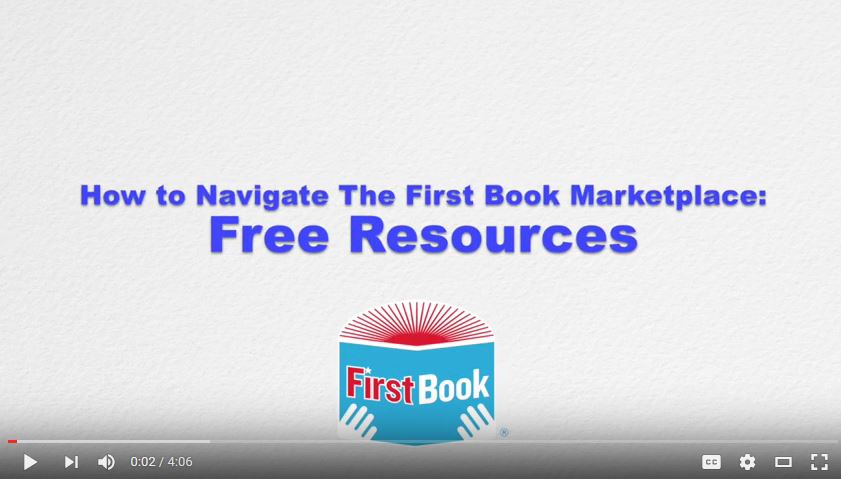
Where can you find free educational resources?
On the First Book Marketplace, of course!
You’ll find tips to encourage family engagement, resources for early childhood education, free subscriptions to online tools and programs and much more. For access, you’ll first need to sign up and log in.
Watch the video below to learn how to access, download and use these great free resources:
The post Find Free Educational Resources on the First Book Marketplace appeared first on First Book Blog.


By: Samantha McGinnis,
on 5/18/2016
Blog:
First Book
(
Login to Add to MyJacketFlap)
JacketFlap tags:
tutorials,
wishlists,
Make The Most of First Book,
Using First Book,
Using the First Book Marketplace,
how-to videos,
popular topics,
The First Book Marketplace,
user dashboard,
Add a tag

Once you’ve registered and logged into the First Book Marketplace there are so many new features to explore!
As we’ve shown, you’ll find new navigation and menus. You can use gift cards and promotional codes. But you’ll also find a new dashboard for account information, a new wishlist feature and a section highlighting topics that are important to educators and program leaders serving children in need.
In today’s video, you’ll learn how to explore the dashboard, how to make a wishlist and learn more about popular topics.
The post How to Use the First Book Marketplace: Wishlists, the Dashboard and Popular Topics appeared first on First Book Blog.


You’ve learned how to navigate the newly redesigned First Book Marketplace. You’ve searched for the books, school supplies and basic needs items you need for your classroom or program and want to purchase them.
What do you do now?
First, you’ll want to make sure you’re logged in. The great educational tools and resources found on the First Book Marketplace are only available to registered members who serve children in need. Logging in will unlock all the functions of the First Book Marketplace.
In this video, you’ll learn what to do once you’re ready to make a purchase. You’ll also learn how to apply discount codes, how to use gift cards and how to distinguish between the two.
Watch to learn more:
The post How To Use the First Book Marketplace: Making Purchases, Using Gift Cards and Promotional Codes appeared first on First Book Blog.


By: Samantha McGinnis,
on 5/10/2016
Blog:
First Book
(
Login to Add to MyJacketFlap)
JacketFlap tags:
Using First Book,
Using the First Book Marketplace,
educational activities,
how to navigate,
how to search,
how-to videos,
mobile friendly sites,
video tutorials,
books,
technology,
school supplies,
First Book Marketplace,
digital learning,
Add a tag

Drumroll please… Today, we introduce to you the newly redesigned First Book Marketplace.
Updated with your needs in mind, your First Book Marketplace is now faster and simpler to use. Powerful new search capabilities and an improved navigation menu make it easy to find the great books and educational resources you’ve come to expect from First Book. And now you can access them all from the palm of your hand — the entire site is mobile friendly!
For years, you’ve generously shared the needs facing your classrooms and programs. Your feedback directly influenced every improvement and enhancement you’ll experience on the upgraded site.
On top of the books and learning tools you love, you’ll also find specially-curated collections on popular topics like family engagement, character development, health and wellness, and diversity. First Book’s entire inventory, including school supplies, technology, digital learning materials, basic needs items and educational activities is more accessible than ever before.
Stay tuned all week as we share videos on how to use some of the great new features of your First Book Marketplace. Start here by learning how to navigate and search the newly designed site:
The post Now Faster and Easier to Use: Your First Book Marketplace appeared first on First Book Blog.


By: Samantha McGinnis,
on 5/5/2016
Blog:
First Book
(
Login to Add to MyJacketFlap)
JacketFlap tags:
mother's day,
Baseball books,
family activities,
family books,
tipsheets,
Mother's day activities,
Search Institute,
Using First Book,
Tips and Resources,
Abuela by Arthur Durros,
Brothers as bat: The True Story of An Amazing All-Brother Baseball Team,
My Name is Yoon by Helen Recorvits,
free resources,
Add a tag
Looking for a great way to celebrate Mother’s Day? Read a book together and try these activities.
The books below are just some of the books identified by Search Institute that model behaviors that make families stronger: collaborating, encouraging and exploring.
Read these books together and use the activities listed after each book to grow together as a family.

The kindness and generosity of the Acerra family helped their twelve sons become the longest-playing all-brother baseball team in history.
This book shows collaborating: learning, growing and solving problems with your child.
Try this after reading:
Your family is like a team. Each person plays a different role and has different talents. To help your family recognize these, sit down as a group and have each person write or draw pictures of a strength they think each member of the family brings to your team. Talk as a family about the work you do to support one another, as well as skills you can teach one another.
Abuela by Arthur Dorros; illustrated by Elisa Kleven

Take flight with Rosalba and her grandmother as they soar in Rosalba’s imagination all over New York City, visiting family and seeing places with special meaning to Abuela.
This book shows exploring: exposing your child to new ideas, experiences and places.
Try this after reading:
Maps offer fun opportunities to talk about and discover places of importance to you.
Talk with your child about familiar locations, like the places where friends and family live and work, then draw a map together that includes those spots. Or, ask your child to invent a world they’d like to travel to, then draw a map of it and pretend you’re visiting that place together. What do you see, smell or hear? Talk with your child about this new world and the things that make it different from your own.
My Name is Yoon by Helen Recorvits; illustrated by Gabi Swiatkowska

Yoon feels unhappy after her family moves from Korea to the United States, until she gets encouragement at home and at school and learns to write her name in English.
This book shows encouraging: praising your child’s efforts and achievements.
Talk and ask questions as you read:
- Tell your child about a time you felt like you didn’t belong. ASK: Has that happened to you? What did you do? Did someone help you feel included?
- Yoon’s parents are proud of her when she sings to them in English. Remind your child about a time you were proud of him or her. ASK: What are you proud of?
Educators and program leaders serving children in need can find more books with tips and activities in the Build Strong Families with Stories section of the First Book Marketplace. Developed in partnership with Search Institute, through generous funding from Disney, each book comes with a FREE downloadable tipsheet with tips and discussion questions like the ones above.
The post Celebrate Mother’s Day: Read a Book Together! appeared first on First Book Blog.


By: Samantha McGinnis,
on 4/18/2016
Blog:
First Book
(
Login to Add to MyJacketFlap)
JacketFlap tags:
resilience,
Kathleen Krull,
free resources,
Kevin Henkes,
character development,
perseverance,
self-control,
Noah Z. Jones,
David Diaz,
Maribeth Boelts,
Lilly's Purple Plastic Purse,
Wilma Rudolph,
Wilma Unlimited,
Using First Book,
Tips and Resources,
character counts,
Those Shoes,
Add a tag
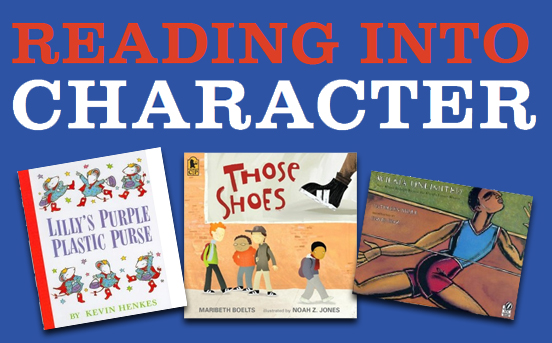
Stories can help children to develop into responsible, caring and contributing citizens.
Use the activities for each book below to teach good character traits like kindness, self-control and perseverance to your students.
To view all the books chosen and to see all the tips and activities suggested for each book, visit the Reading Into Character Section on the First Book Marketplace.
This story models self-control: being able to deny your short-term impulses in order to stay focused and pursue what is really important

Lilly loved school, until her teacher took away her fabulous movie star sunglasses, her three shiny quarters and her brand new purple plastic purse.
Ask these questions after reading the story:
- Lilly wants to show off her new things, even though she knows it’s not the right time. Why do you think is it so hard to wait when you’re excited?
- Even though Lilly loves Mr. Slinger, she is furious with him for taking away her things. Why is she so angry? Should she be angry?
This story models resilience and perseverance: honoring your word and your intentions by working hard toward an important goal, despite setbacks and challenges
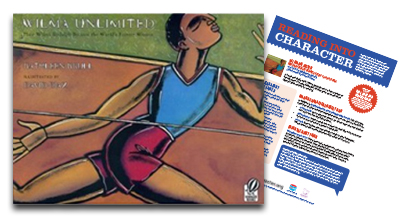
A small and sickly child, Wilma Rudolph wore a heavy brace on her leg when she was a little girl, but she grew up to win three Olympic gold medals for running.
Try this activity to learn more about resilient athletes:
Who are today’s women’s sports stars? Ask your students to choose their favorite female champions in track, basketball, tennis, soccer, and more. Research their lives. Create a Women’s Sports Hall of Fame for your classroom.
Those Shoes written by Maribeth Boelts, illustrated by Noah Z. Jones
This story models kindness and compassion: valuing others so much that you show them respect and offer help to them as a way of honoring their value

Like all the other boys in school, Jeremy wants black high tops with two white stripes. But when he finally gets a pair, he realizes that he needs to give them away.
Try this activity to practice kindness and compassion:
Investigate local charities that welcome donations of good-as-new clothing, toys, books, or other useful items. Be sure to play close attention to their donation guidelines. If feasible, organize a class- or school-wide donation drive.
Developed as a joint project with Character.org and with generous support from Disney, each hand-picked book in the Reading Into Character section is paired with a FREE downloadable tip sheet.
The post Teaching Good Character with Books appeared first on First Book Blog.


By: Samantha McGinnis,
on 4/7/2016
Blog:
First Book
(
Login to Add to MyJacketFlap)
JacketFlap tags:
Collaboration,
Critical Thinking,
Balloons Over Broadway,
Using First Book,
Tips and Resources,
Home At Last,
Lon Po Po: A Red Riding Hood Story,
Partnership for 21st Century Learning,
Creativity,
Communication,
Add a tag

Creativity, critical thinking, communication and collaboration are critical skills for children to learn so they can succeed in today’s world.
Use the books below and the guided questions to teach these concepts found in each story.
You’ll find a well-known fable told from another culture’s perspective, an inspiring tale about a family working together and the true story of the Macy’s Thanksgiving Parade. To view all the books chosen and to see all the tips and activities suggested for each book, visit the Learn for Life section.
When sisters Shang, Tao and Paotze get a surprise visitor while their mother is away, they have to figure out if it’s really their Po Po (grandmother) who is at the door.
Lon Po Po is about critical thinking and how you can use lots of clues to figure out a problem. Use these questions and ideas to get your child thinking and talking about the story:
- What clues did the sisters have to figure out
- The sisters tricked the wolf. Do you think it was right or wrong to trick the wolf? Why or why not? Have you ever tricked someone? What happened?
Home At Last written by Susan Middleton Elya, illustrated by Felipe Davalos
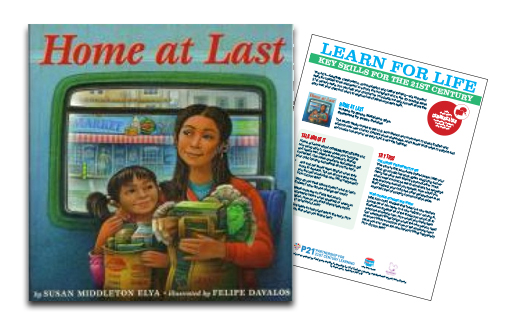
The Patiño family moves to the U.S. from Mexico and must learn to speak English and adapt to their new country. Despite some challenges, Ana’s family finds ways to support and encourage one another as they build a new life together.
Home at Last is about communicating and how being able to clearly share your thoughts and needs with others is important to feeling connected. Use these questions and ideas to get your child thinking and talking about the story.
- Ana and her family learn English when they move to America. Tell me about a time when you learned something new. What happened? How did you feel?
- Why do you think Mamá doesn’t want to learn English? How did she change her mind?
This real-life story shares the life of Tony Sarg, the talented puppet-maker who helped the Macy’s Thanksgiving Day Parade come to life.
Balloons Over Broadway is about using CREATIVITY to build on existing ideas to make something new and different. Use these questions and ideas to get your child thinking and talking about the story.
- What are some different ways Tony uses his creativity in the story?
- Tony is always looking at his balloons and making changes so that they work better. Why was it important that he kept improving the balloons? How do you think about making something better?
Developed as a joint project with the Partnership for 21st Century Learning and with generous support from Disney, each hand-picked book in the Learn for Life section is paired with a FREE downloadable tip sheet. These tipsheets designed to help you equip the kids you serve with the key 21st century skills they need to thrive in school and in life.
The post Books that Teach Creativity, Critical Thinking, Communication and Collaboration appeared first on First Book Blog.


Books are great tools for sparking conversation between adults and children.
They can inspire conversation and activities around a diverse range of topics, including feelings, imagination and different family structures. These conversations can help you share lessons with students and can deepen bonds between family members.
Use the books and activities below to get kids and families talking!
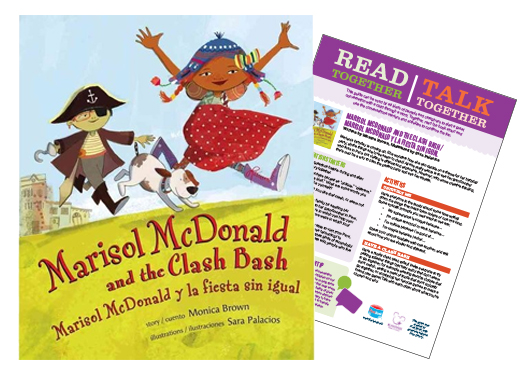
Marisol’s birthday is coming up. She wonders how she can decide on a theme for her birthday party; all the things she loves seem to clash! All she really wants is to see her grandmother who lives in Peru, but visiting is difficult and expensive. However, with some creative thinking, there may be a way to plan the perfect party and see her abuela.
Try this activity with this book:
Have everyone in the family spend some time writing down the things that make them unique or one of a kind. Some specific prompts you may want to use are:
- My appearance is unique because…
- I’m unique at school or work because…
- I’m unique because I’m good at…
- I’m unique because I enjoy…
Share your unique qualities with one another, and talk about how you are similar and different.
Pink was the runt of a litter of 12 piglets. He had trouble growing and thriving until he was welcomed and cared for by a dachshund foster mom. Real photographs show the development of the unlikely bond between puppies and pig in this touching true story.
Try this activity with this book:
Talk and ask questions before, during and after reading the story together. One question you could ask is “Many people in our lives can show us that they care about us, not just our biological families. Who are some people who care about you? How do they show you that they care about you?”
Flower Garden is a sweet, rhyming story about the work that goes into creating a very special surprise for a mother’s birthday.
Try this activity with this book:
Take some time to go on a nature walk by visiting a nearby park or walking around your neighborhood, and talk about what you see. Talk about the ways in which nature looks different during the different seasons. If possible, collect some bits and pieces of natural objects along your way and place them in a bag. When you get home, use the natural objects you have collected, glue, and some paper or cardboard to create a nature poster.
These are just three of the books from First Book’s Read Together, Talk Together section that can be used to start conversations. Made possible by generous support from Disney, each hand-picked book is paired with a FREE downloadable tip sheet.
For all of our tips and an even larger selection of books, visit the Read Together, Talk Together section on the First Book Marketplace.
The post Activities to Spark Conversation Between Adults and Children appeared first on First Book Blog.

“Working at a Title I school you learn pretty quickly that if basic needs aren’t met, students aren’t able to move past those needs. No one can learn when they’re hungry. When students are hungry they’re distracted and sleepy. It’s amazing to watch a student eat a snack – sometimes it’s almost like you can see their brain switch on!” – Emily Townsend, Elementary School Counselor, Portland, Oregon
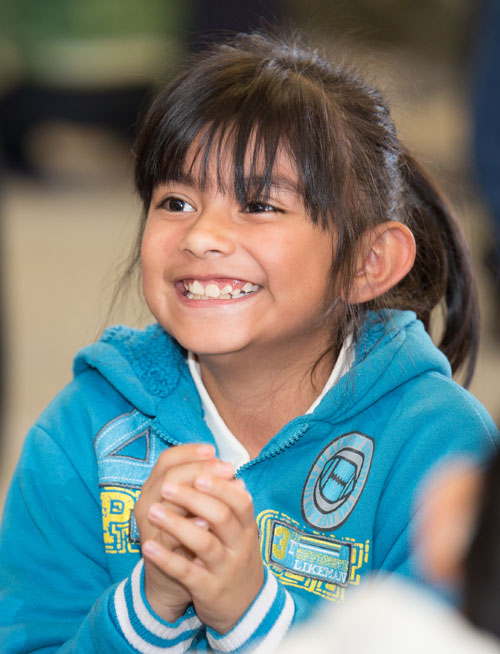 So many educators and program leaders know that nutrition is essential to a child’s ability to learn. But many of the students they serve don’t have access to the nutritional food they need to succeed.
So many educators and program leaders know that nutrition is essential to a child’s ability to learn. But many of the students they serve don’t have access to the nutritional food they need to succeed.
How does food fuel learning in your classroom or program?
March is National Nutrition Month and to celebrate we have an exciting opportunity for you to help the kids you serve do their best.
If you are a registered member of First Book’s community of educators working with kids in need, you can enter to win a variety of nonperishable food like the items shown below and a set of books to fuel students’ learning in your classroom, school or program.
Simply answer the question “How does food fuel learning in your classroom or program?” by commenting on this Facebook status between March 7 and March 11. See rules below.

*Entries by individuals serving kids in need who are registered First Book will be eligible to win a selection of nonperishable food items like those featured above and a set of books to fuel learning in their classroom or program, up to a $200 value. Eligible educators should enter to win by answering the question “How does food fuel learning in your classroom or program?” by commenting on this status on First Book’s Facebook page by 11:59 pm EST on March 11, 2016. A winner will be chosen at random from all eligible entries on March 14 and notified via email. The nonperishable food and books awarded to the winner will be selected for age range and number of children served. Nonperishable food is available on the First Book Marketplace in bulk only.
The post Free Food to Fuel Your Students’ Learning appeared first on First Book Blog.

Are you celebrating Día this year? We have five fun ideas to fuel your celebration planning.
In its 20th year, Día de los niños, Día de los libros (Children’s Day, Book Day – or Día) is the annual celebration of bookjoy created by children’s author Pat Mora. The nationally recognized initiative emphasizes the importance of literacy for all children, from all backgrounds and creatively links them to the gift of reading.
March is the perfect time to plan the details of your Día celebration. Now is the time to pick your location, check and evaluate your book inventory and invite your guests. Try these great ideas and find more tips for organizing and planning your celebration in our downloadable Día guide.
First Book exists to help get new, high-quality books into the hands of kids in need. It is just about the best mission a nonprofit could have. (At least, we think so.)
But how does it actually happen?
Anyone who works with kids in need can sign up, for free, with First Book. Once they do, they have two options:
The Marketplace is an online store, where over 5,000 great titles are available:
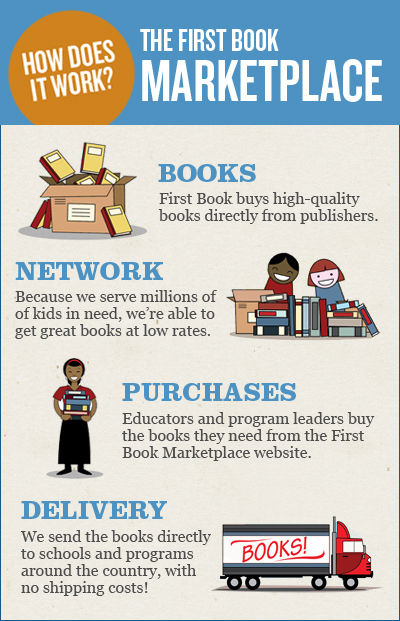
The National Book Bank is the nation’s largest clearinghouse for donated books from publishers.

The post How Does First Book Work? appeared first on First Book Blog.


 Ghosts in the House! written and illustrated by Kazuno Kohara
Ghosts in the House! written and illustrated by Kazuno Kohara Los Gatos Black on Halloween written by Marisa Montes and illustrated by Yuyi Morales
Los Gatos Black on Halloween written by Marisa Montes and illustrated by Yuyi MoralesAttack of the Shark-Headed Zombie by Bill Doyle
 Lockwood & Co. #1: The Screaming Staircase by Jonathan Stroud
Lockwood & Co. #1: The Screaming Staircase by Jonathan Stroud





 Use Guided Reading Levels to find the perfect books for every child you serve. Thanks to the feedback from our community of educators,
Use Guided Reading Levels to find the perfect books for every child you serve. Thanks to the feedback from our community of educators, 
 Want to keep kids’ minds and bellies full while they are out of school this summer?
Want to keep kids’ minds and bellies full while they are out of school this summer?











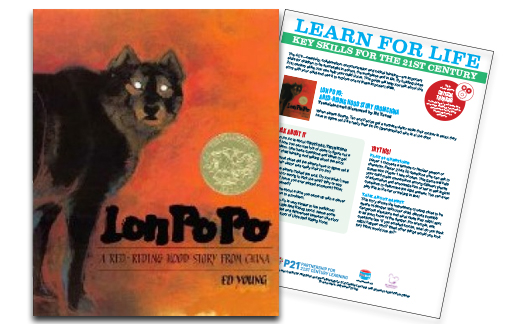

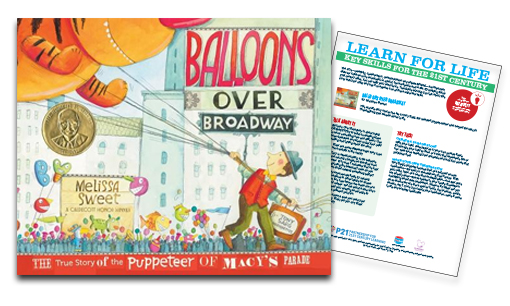




 So many educators and program leaders know that nutrition is essential to a child’s ability to learn. But many of the students they serve don’t have access to the nutritional food they need to succeed.
So many educators and program leaders know that nutrition is essential to a child’s ability to learn. But many of the students they serve don’t have access to the nutritional food they need to succeed.

